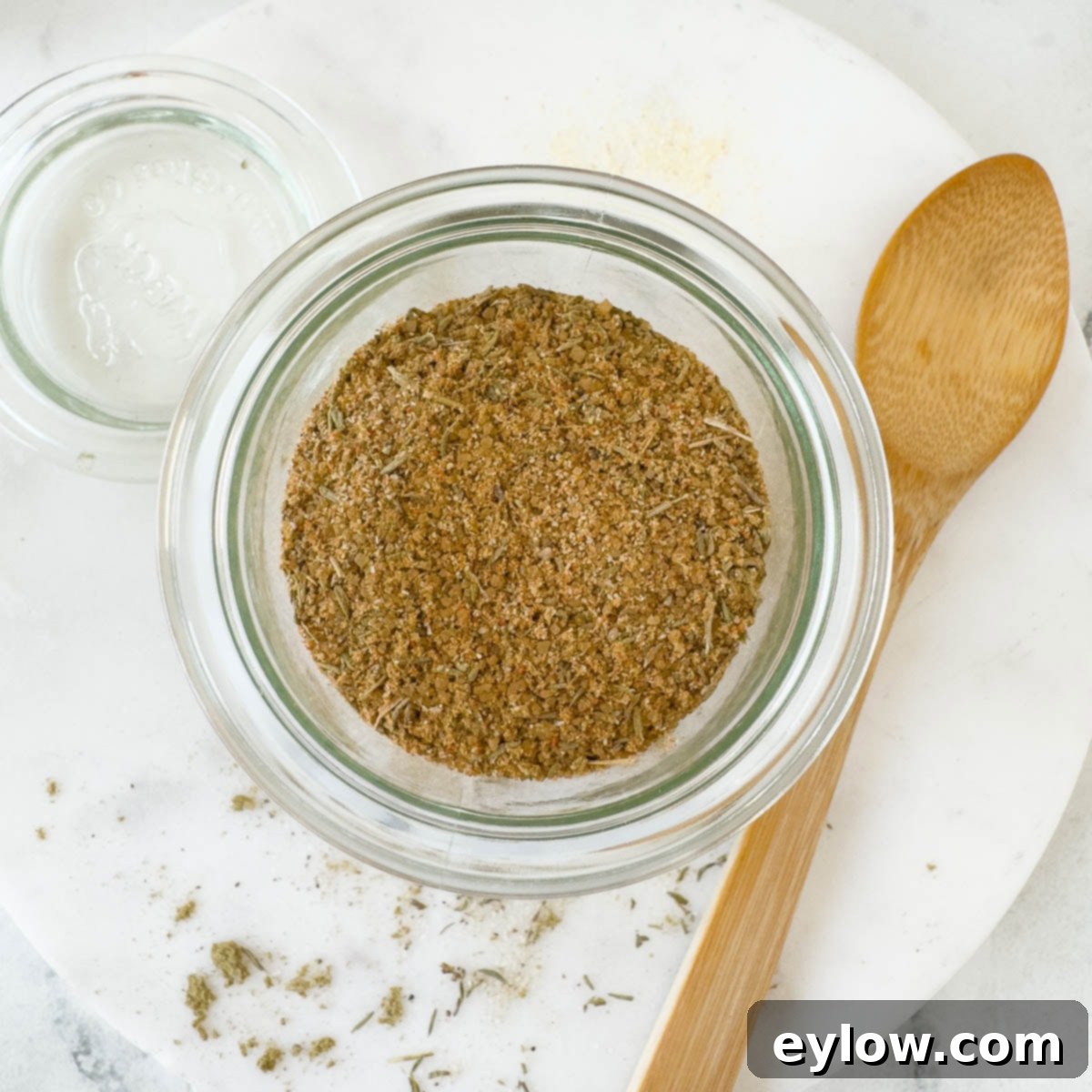The Best Homemade Turkey Rub: Your Ultimate Dry Rub for Roasted & Smoked Turkey (SEO Friendly!)
Preparing a flavorful turkey, whether for Thanksgiving, a special family dinner, or a simple weeknight meal, starts with the perfect seasoning. This incredibly easy and effective turkey rub recipe is my absolute favorite for infusing poultry with immense flavor without any unnecessary fuss. It’s truly a versatile blend, serving as an outstanding Thanksgiving turkey dry rub, an aromatic seasoning for smoked turkey breast, or even a simple yet savory touch for roasted chicken. What makes this homemade turkey seasoning blend stand out is its masterful balance: earthy and herby notes from rubbed sage and thyme, complemented by the savory depth of garlic and onion, all harmonized with a touch of sweetness from brown sugar. No matter your cooking method – roasting, smoking, grilling, or even air frying – this meticulously crafted turkey rub seasoning recipe consistently delivers a rich, savory, and unforgettable flavor experience every single time.
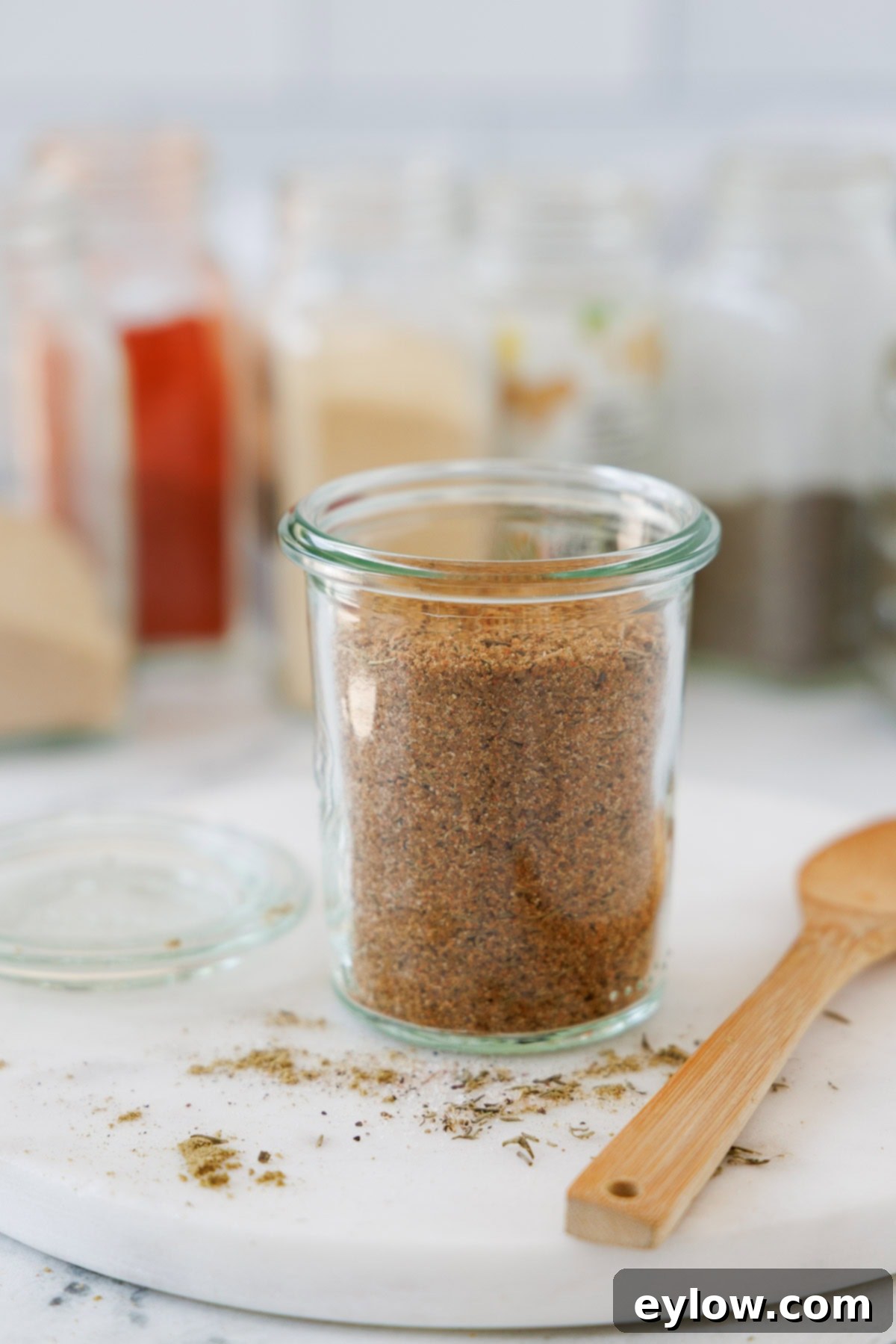
I originally developed this specific turkey rub seasoning recipe to elevate my Thanksgiving turkey, aiming for a taste that evokes warmth and tradition. Since then, it has become my trusted companion for my smoked turkey breast, creating a deeply flavorful and beautifully bronzed crust. This blend offers a delightful and flavorful departure from my usual BBQ-style rub, making it an excellent choice as a turkey smoking rub or a classic turkey dry rub for any roasted poultry. Opting to make your own turkey seasoning blends provides several significant advantages: you completely avoid fillers, artificial preservatives, or any mystery ingredients often found in commercial spice mixes. Instead, you get pure, vibrant flavor that you can confidently trust and customize to your exact preferences.
Why This Homemade Turkey Dry Rub Will Be Your New Favorite
This dry rub isn’t just another seasoning blend; it’s a game-changer for anyone looking to achieve perfectly seasoned poultry with minimal effort and maximum flavor. Here’s why you’ll absolutely adore this turkey dry rub:
- Effortless to Prepare: Forget complicated steps or exotic ingredients. This turkey rub recipe comes together quickly and easily with a simple handful of common pantry spices, making it accessible for even the busiest home cooks.
- Wholesome, Clean Ingredients: When you make your own homemade turkey seasoning blend, you have complete control. There are no unwanted fillers, artificial preservatives, or any questionable additives—just pure, high-quality spices and herbs for natural, robust flavor.
- Salt-Free Customization: One of the biggest advantages of this blend is its salt-free base. This flexibility allows you to precisely control the amount of salt you add, tailoring it perfectly to your dietary needs or personal taste preferences, ensuring a perfectly seasoned bird every time.
- Remarkably Versatile: While it excels as a Thanksgiving turkey rub, its applications extend far beyond. This seasoning works beautifully on smoked turkey breast, whole roasted chickens, succulent Cornish hens, and even pork tenderloin, making it a truly multi-purpose spice blend.
- Explosive, Balanced Flavor: This dry rub is expertly balanced with classic poultry herbs like sage and thyme, a subtle hint of sweetness from brown sugar, and rich, savory depth from garlic and onion powder. The result is a complex, aromatic, and undeniably delicious flavor profile that enhances, rather than overwhelms, the natural taste of your poultry.
Essential Ingredients for Your Perfect Turkey Rub
Crafting this exceptional turkey seasoning is straightforward, relying on a blend of common spices that work synergistically to create a deeply satisfying flavor. Each ingredient plays a crucial role in achieving the rub’s signature taste and texture:
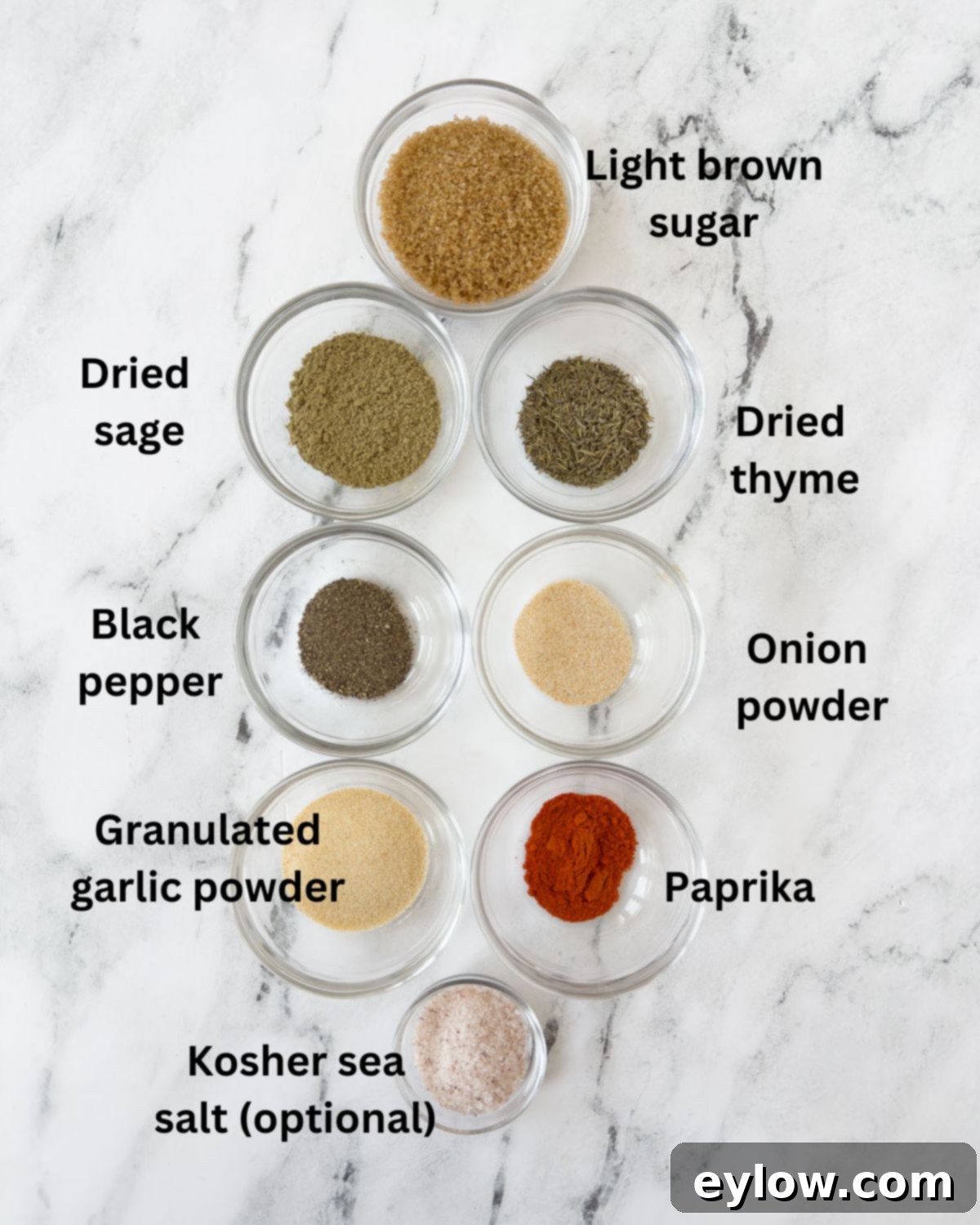
- Brown Sugar: This isn’t just for sweetness; brown sugar adds a delicate molasses note that perfectly balances the savory herbs. Crucially, it also aids in developing that coveted golden, caramelized crust on your turkey, especially when used as a turkey dry rub for roasting, grilling, or smoking. The sugars melt and crisp, adding incredible texture.
- Sage: Indispensable in any homemade turkey seasoning, sage is the cornerstone of classic holiday flavor. Its earthy, slightly peppery, and pine-like notes are synonymous with poultry. While ground sage is readily available, rubbed sage (which is lighter and less concentrated, requiring a slightly larger quantity) offers a more delicate texture and flavor distribution.
- Granulated Garlic or Garlic Powder: Providing an essential earthy depth and a wonderfully aromatic quality, granulated garlic or garlic powder makes this turkey rub recipe richly savory. It infuses the meat with a foundational flavor that complements all the other spices.
- Dried Thyme: Layering in herbaceous, slightly woody, and minty undertones, dried thyme is vital for both smoked turkey rub and roasted turkey applications. It brings a fragrant, classic poultry herb profile that marries perfectly with sage.
- Paprika (Regular or Smoked): Whether you opt for regular or smoked paprika, it contributes subtle warmth and a beautiful, rich reddish-orange color to your poultry skin. If you’re specifically making this as a turkey smoking rub, smoked paprika will amplify that smoky essence beautifully, enhancing the overall profile.
- Onion Powder: Offering a mild, savory-sweet note, onion powder helps to round out the complex flavors of this turkey rub seasoning recipe. It adds an underlying depth that enhances the garlic and herbs without being overpowering.
For precise measurements of these ingredients, along with recommendations for salt and black pepper, please refer to the comprehensive recipe card located at the end of this article.
Customizing Your Turkey Seasoning: Substitutions and Variations
One of the joys of making your own spice blends is the freedom to adapt them. This turkey seasoning is incredibly flexible, allowing you to tailor it to your personal taste, dietary needs, or what you have on hand. Here are some fantastic ways to customize your blend:
- Sea Salt (Optional): As written, this turkey rub is salt-free, giving you maximum control. For those who prefer to include salt directly in the blend, I recommend adding 1 to 1½ tablespoons of high-quality kosher sea salt per batch. If you’re sensitive to sodium or planning to brine your turkey separately, you can easily omit it entirely.
- Fennel for an Anise Kiss: To introduce a subtle, light licorice note that pairs wonderfully with poultry, consider adding ground fennel. For a more aromatic and concentrated flavor, fennel pollen is an excellent, albeit potent, choice – start with a smaller amount and adjust to your liking.
- Amplify the Smoke with Paprika: If you’re already using regular paprika, swapping it for smoked paprika will impart a deeper, more pronounced smoky flavor. This is particularly effective if you’re preparing this as a smoked turkey rub or a turkey smoking rub, enhancing the overall barbecue profile.
- Sugar-Free Alternatives: For a lower-carb variation, you can simply omit the brown sugar altogether. Alternatively, a golden monk fruit blend can provide a similar sweetness without the carbohydrates. Keep in mind that sugar aids in browning, so a sugar-free rub may result in a slightly lighter colored crust.
- Herb Swaps for New Aromas: The beauty of this turkey rub seasoning recipe is its adaptability. Feel free to experiment with other complementary herbs such as earthy rosemary, delicate marjoram, bold oregano, fresh parsley, or even a hint of ground bay leaf for a more complex and aromatic profile.
- Add a Touch of Heat: For those who enjoy a little kick, a pinch of cayenne pepper or red pepper flakes can be added. Start with ¼ teaspoon and increase gradually until you reach your desired level of spice.
- Citrus Zest (Dried): For a brighter, fresher note, consider adding a teaspoon of dried orange or lemon zest. This adds an aromatic layer that cuts through the richness of the turkey.
Chef’s Tip: The Art of Salting Your Turkey Rub
I consciously choose not to include salt directly in my turkey rub seasoning. My reasoning is simple: I prefer to season poultry separately with salt, whether through brining or a direct application, to maintain precise control over the sodium content. This method ensures that the turkey is perfectly seasoned to my taste or dietary requirements. If, however, you prefer the convenience of an all-in-one rub, feel free to mix in 1 to 1½ tablespoons of kosher sea salt per batch (which yields approximately 7 tablespoons of rub in total). For the best results, I highly recommend using quality kosher sea salts like Real Salt Kosher Sea Salt or La Baleine Kosher Sea Salt. These are often flakier and milder than Morton kosher salt, which also works well. A crucial point: avoid standard table salt. Its dense, fine crystals can lead to over-salting, and its additives often impart a flat, metallic taste that can detract from the rub’s vibrant flavors.
Crafting Your Homemade Turkey Rub Seasoning
Making this turkey rub seasoning is incredibly simple, and there are a couple of methods to achieve the perfect blend. While you could simply add all the spices to a jar and shake vigorously to combine them, I personally prefer to take an extra step. My go-to method involves grinding the blend in a mortar and pestle. This process isn’t just for show; it actively works to bring the individual flavors together more uniformly, creating a finer texture that adheres beautifully and seamlessly to the poultry skin. This finer texture is especially advantageous when you’re using this turkey rub for smoking or roasting, as it helps create an even crust and ensures consistent flavor penetration.
This recipe is perfectly scaled to make approximately 4 ounces of seasoning. This amount is generally sufficient for two whole bone-in turkey breasts or a medium-sized whole turkey, depending on the bird’s specific size and your desired level of seasoning coverage.
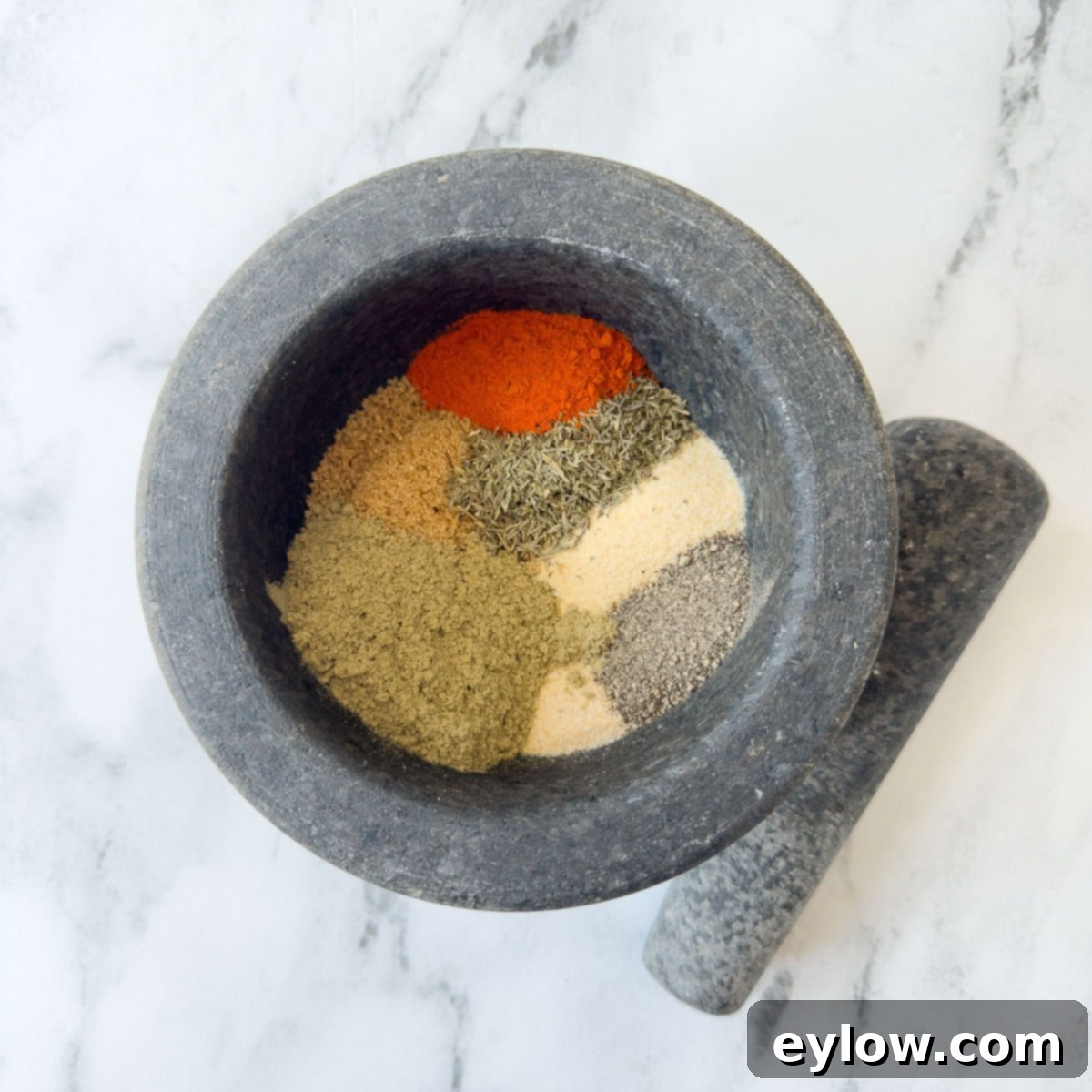
- Begin by adding all of the specified turkey seasoning ingredients (including salt, if you’ve decided to incorporate it directly into the blend) to your mortar and pestle. If you don’t have a mortar and pestle, a clean jar with a tight-fitting lid will also work for shaking.
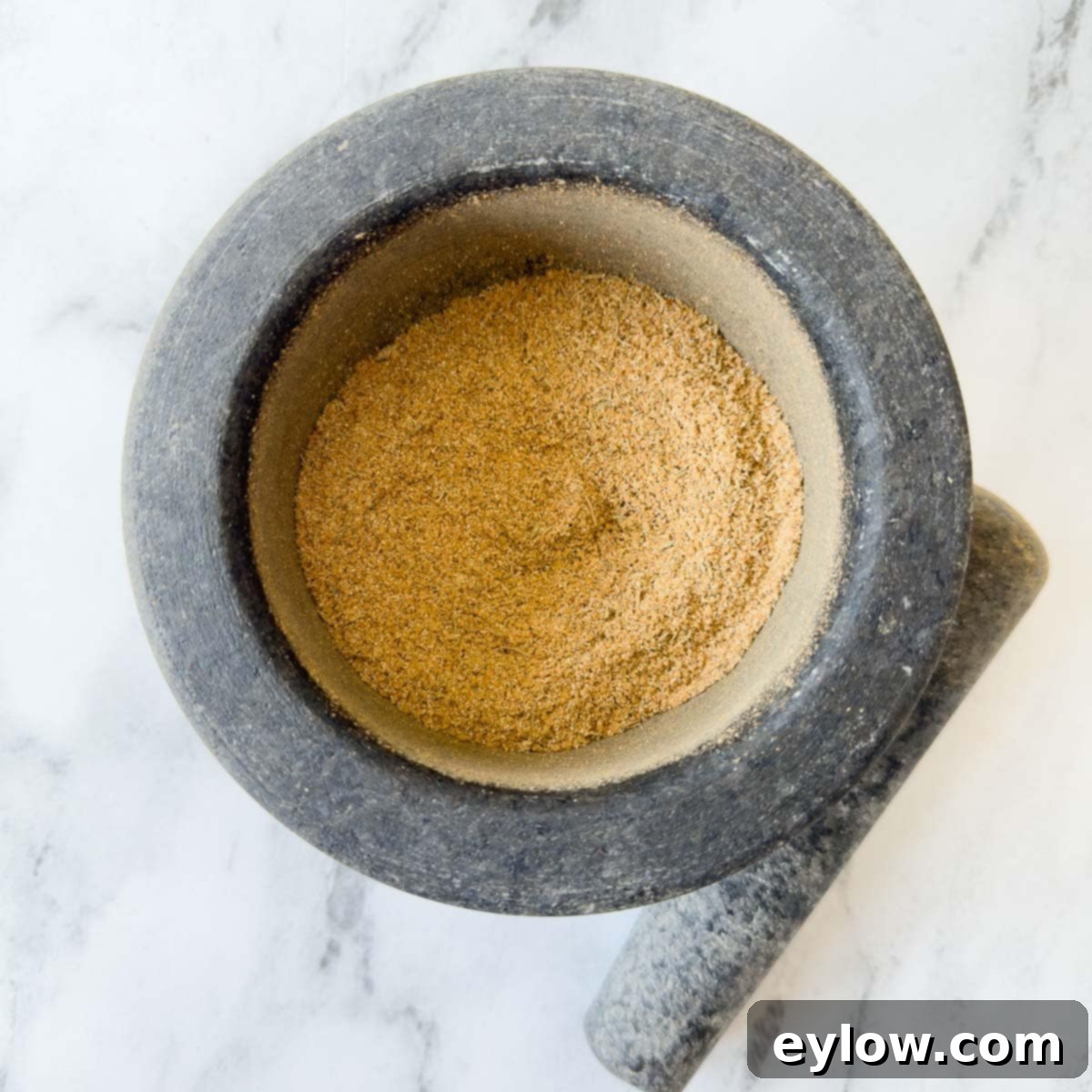
- If using a mortar and pestle, gently but firmly grind the herbs and spices together. Continue until the blend achieves a consistently fine texture, ensuring all the flavors are thoroughly integrated. If using a jar, simply shake vigorously for 1-2 minutes until thoroughly mixed.
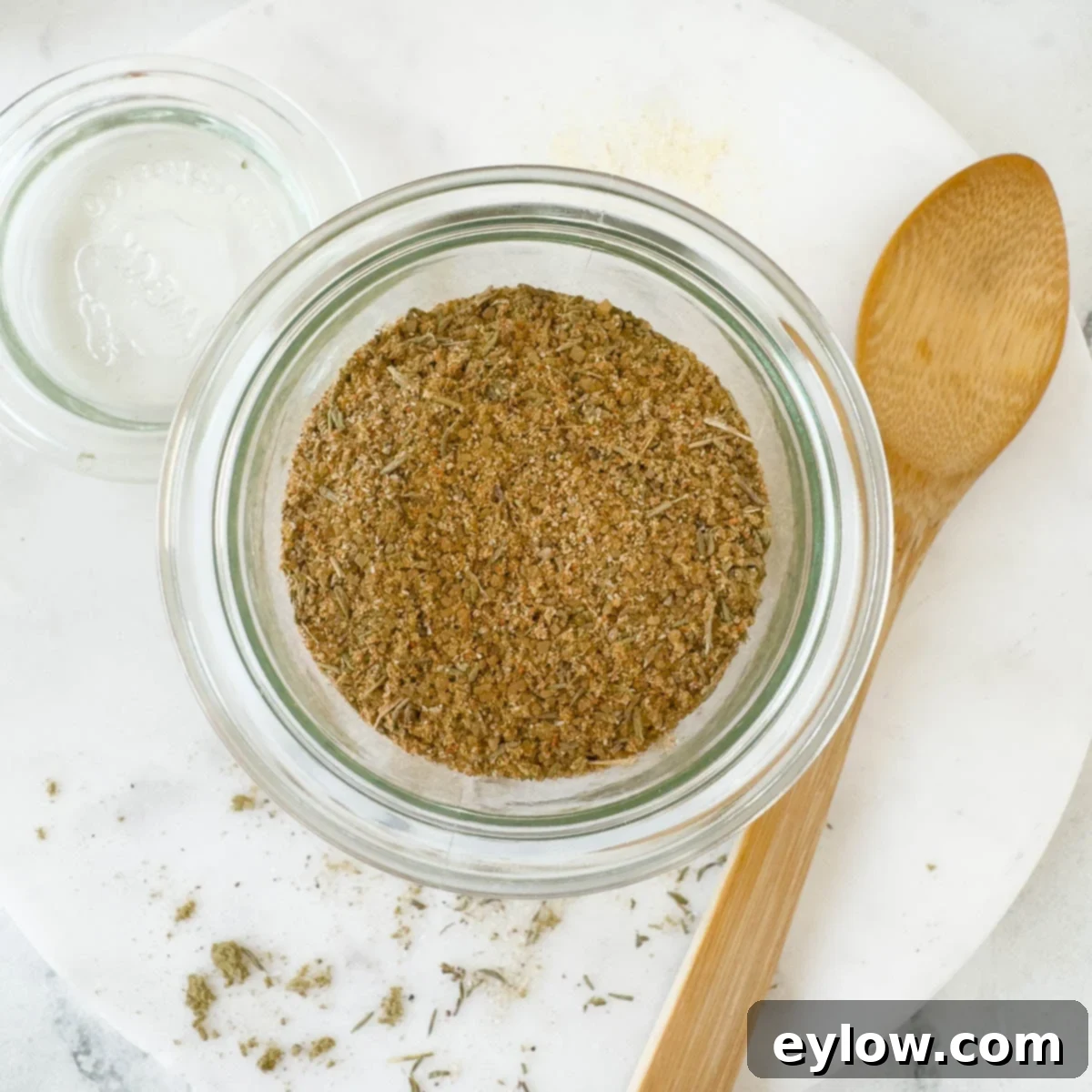
Once blended, your homemade turkey rub seasoning is ready for immediate use or can be stored for future culinary adventures. Transfer it to an airtight container and enjoy the freshness and robust flavor of your custom blend.
Mastering the Application: Roasting vs. Smoking Your Turkey
This versatile turkey rub was initially developed with my smoked turkey breast in mind, a method where the consistently lower cooking temperature and moist environment allow the brown sugar to caramelize slowly and evenly, building an incredibly flavorful and attractive crust. This slow caramelization is key to deep flavor. The rub also performs beautifully on rotisserie turkey, where the constant rotation ensures even cooking and helps prevent any scorching of the delicate skin. However, adapting the rub for different cooking methods is essential to achieve optimal results, especially when dealing with higher heat.
If you’re planning on oven-roasting a whole bird at temperatures of 325°F or higher, it’s important to note that the sugar in the rub can darken significantly faster under direct high heat. This can lead to a beautifully crisp skin, but also risks burning if not monitored. Here are a few crucial tweaks and tips to ensure the best possible outcome when oven-roasting:
- Adjust Sugar Content: To mitigate rapid browning, consider reducing the amount of brown sugar slightly. Use 2 tablespoons instead of the full ¼ cup per batch of rub. For a very long roast or if you prefer less sweetness, you can even skip the sugar entirely.
- Strategic Foiling: If you observe the turkey skin browning too quickly and becoming excessively dark toward the end of the roasting time, simply tent the turkey loosely with aluminum foil. This clever technique will shield the skin, allowing the bird to finish cooking through without any risk of burning.
- Rub Beneath the Skin: For deep flavor penetration without as much surface caramelization, a smart strategy is to spread some of the turkey rub directly beneath the skin, often combined with a thin layer of butter. This ensures the meat absorbs the seasoning while protecting the skin from over-browning.
- Pre-Seasoning is Key: For any method, apply the dry rub liberally to the turkey at least 12 hours, and ideally up to 24 hours, before cooking. This allows the rub to act as a dry brine, drawing moisture from the skin and letting the flavors penetrate the meat more deeply. Pat the turkey very dry before applying the rub for the crispiest skin.
- Moisture Management for Smoking: When using this as a turkey smoking rub, ensure you maintain a consistent temperature and a moist environment within your smoker (e.g., using a water pan). This helps the sugar caramelize slowly rather than burn and keeps the turkey from drying out.

While this turkey rub seasoning shines brightly in my Smoked Turkey Breast recipe, its incredible flavor profile makes it fantastically versatile. Don’t limit its use! It’s equally outstanding on roasted chicken, lending a gourmet touch to everyday meals. Try it on tender Cornish hens for an elegant presentation, or even experiment with it on pork tenderloin for a savory and slightly sweet crust. The possibilities are truly endless once you have this fantastic blend in your culinary arsenal.
Beyond the Bird: Versatile Uses for Your Homemade Rub
While designed to be the ultimate turkey dry rub, the balanced and savory-sweet profile of this homemade seasoning makes it incredibly versatile across a variety of dishes. Don’t let it sit idle between holiday feasts! Here are some creative ways to incorporate this delicious blend into your cooking:
- Chicken, Any Way You Like It: This rub is phenomenal on chicken. Use it as a dry rub for whole roasted chicken, chicken breasts, thighs, or wings. It creates a beautifully crispy skin and infuses the meat with a rich, herbaceous flavor that’s perfect for grilling, baking, or air frying.
- Pork Perfection: The sweetness of brown sugar and the earthy herbs are a natural complement to pork. Rub it generously on pork tenderloin before roasting or grilling, sprinkle it on pork chops for extra flavor, or even mix it into ground pork for meatballs or burgers.
- Elevate Vegetables: Don’t underestimate its power on vegetables! Toss root vegetables like carrots, parsnips, and potatoes with olive oil and this rub before roasting for a savory side dish. It’s also great on grilled corn on the cob or roasted broccoli.
- Flavorful Gravy and Soups: Stir a teaspoon or two into your turkey gravy for an extra layer of depth, or add it to chicken noodle soup or a creamy potato soup for a subtle herbaceous boost.
- Compound Butter: Mix a tablespoon of the rub into softened butter to create a compound butter. Spread this on corn on the cob, use it to baste your turkey, or simply melt it over mashed potatoes.
Storing Your Homemade Turkey Seasoning
Proper storage is key to maintaining the potency and freshness of any homemade spice blend. This turkey seasoning blend will keep exceptionally well for an extended period, ensuring you have delicious flavor at your fingertips whenever you need it. To maximize its shelf life and preserve its aromatic qualities, store the rub in an airtight container. Choose a cool, dark place, such as a pantry or a cupboard away from direct sunlight and heat sources (like your stove). Under these ideal conditions, your homemade turkey rub can maintain its peak flavor for up to 6 months. Always remember to label and date your container clearly so you know exactly when it was made and when it’s best to refresh your batch.
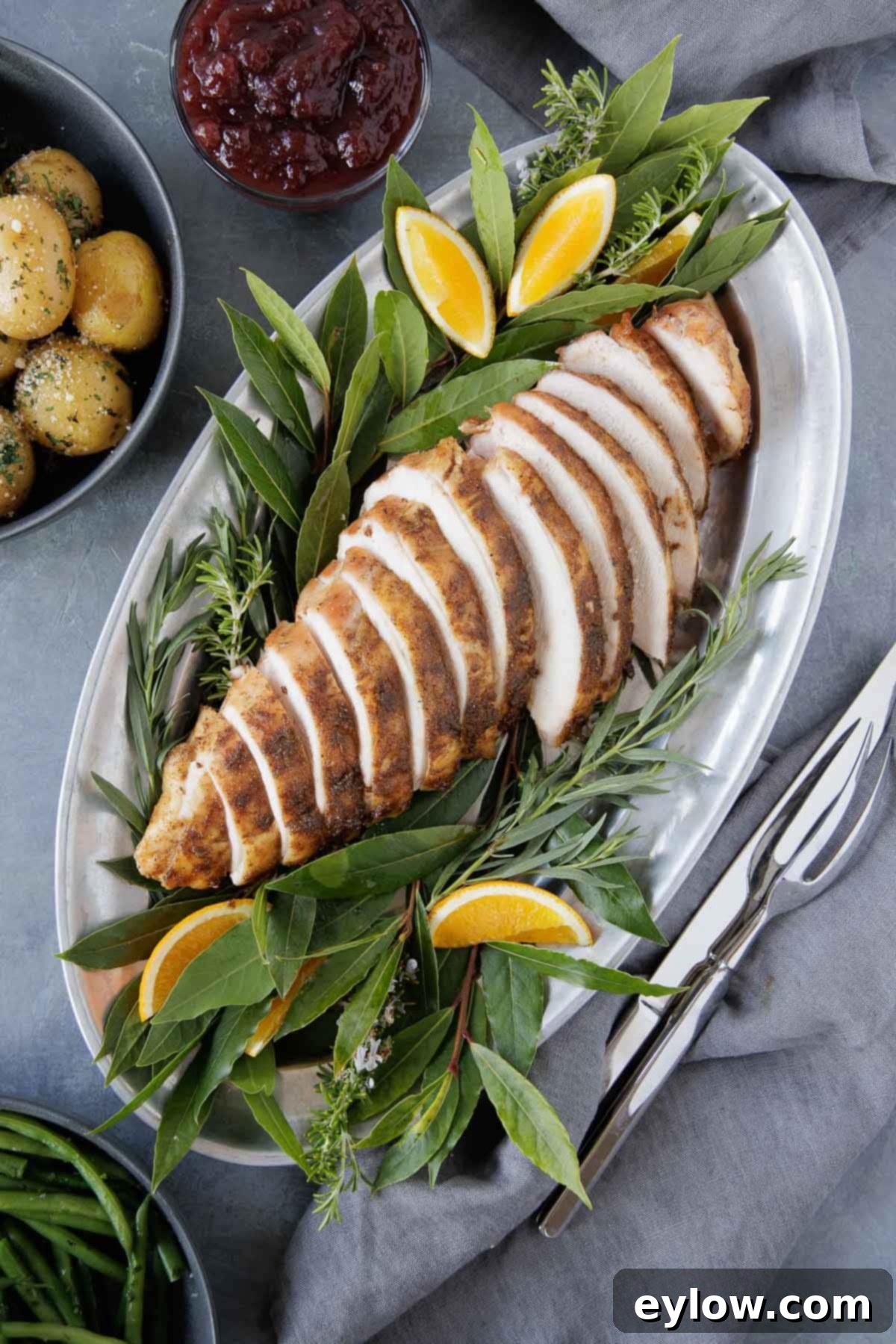
Turkey Rub Recipe FAQs
Yes, absolutely! This homemade turkey rub is naturally gluten-free as it contains only pure spices and herbs. There are no added fillers, binders, or hidden gluten-containing ingredients in this recipe. However, to be absolutely certain, always double-check the labels of any store-bought individual spices you use, as some brands may include anti-caking agents or other additives that could contain gluten.
Indeed, you can! This version of the turkey rub is intentionally designed to be salt-free, giving you complete control over the sodium content. This is particularly beneficial for those managing their sodium intake or planning to use a brining method for their turkey. If you prefer to have salt already integrated into your blend for convenience, feel free to add 1 to 1½ tablespoons of kosher sea salt to the mix.
Absolutely! This versatile seasoning blend is fantastic on a wide variety of meats. It works wonders on chicken, whether you’re roasting a whole bird, grilling breasts, or crisping up wings. It’s also excellent on Cornish hens for a special touch. Don’t stop there – try it on pork tenderloin or pork chops for a delicious sweet and savory flavor profile. It truly shines on any type of smoked or roasted poultry, making it a go-to seasoning for your kitchen.
Yes, unequivocally! In fact, this homemade turkey rub seasoning recipe was specifically developed with Thanksgiving turkey in mind. Its blend of classic holiday herbs, savory notes, and a hint of sweetness is designed to perfectly complement the traditional flavors of a festive turkey. It works beautifully whether you’re roasting a whole turkey for the centerpiece of your holiday meal or simply preparing a turkey breast.
Definitely! Applying this turkey dry rub the night before, or even up to 24 hours in advance, is highly recommended for the best flavor and texture. This extended contact time allows the seasoning to penetrate deeper into the meat, acting much like a dry brine. For optimal results, refrigerate the seasoned turkey uncovered or lightly covered. This exposure to air helps to dry out the skin, which is crucial for achieving that wonderfully crisp and golden skin when cooked, while the seasoning works its magic.
Explore More Homemade Seasoning Recipes
Embracing the practice of making your own seasoning blends at home unlocks a world of culinary benefits. It guarantees fresher, more vibrant flavors, eliminates unnecessary additives and preservatives often found in commercial products, and gives you complete control over every ingredient that goes into your food. Dive into these other fantastic homemade seasoning recipes to elevate your cooking:
- Homemade Everything But the Bagel Seasoning
- Homemade Taco Seasoning Mix and Ways to Use It
- Homemade BBQ Spice Rub
- Blackened Mahi Mahi (Air Fryer Recipe)
Did You Make This Flavorful Turkey Rub?
If you’ve taken the plunge and created this fantastic homemade turkey seasoning, I would absolutely love to hear about your experience! Your feedback is incredibly valuable, and I truly enjoy hearing how these recipes turn out for you. Please take a moment to add your comments below. And if you loved this recipe and found it elevated your poultry to new heights, don’t hesitate to give it a 5-star rating! Your ratings and reviews are immensely helpful to other readers looking for delicious and reliable recipes.
📖 Recipe
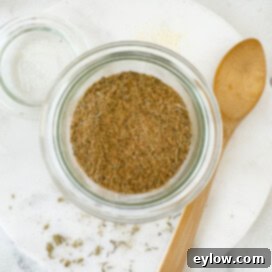
Homemade Turkey Dry Rub Seasoning
Sally Cameron
Pin Recipe
Equipment
-
Jar with a tight fitting lid
Ingredients
- ¼ cup light brown sugar
- 1 tablespoon granulated powdered garlic
- 1 tablespoon sage
- 2 teaspoons dried thyme
- 1 teaspoon paprika regular or smoked
- 1 teaspoon ground black pepper
- 1 teaspoon onion powder
Optional
- 1 – 1 ½ tablespoons kosher sea salt if you prefer it in the blend
- ½ teaspoons ground fennel
Instructions
-
Add all ingredients (and salt if using) and grind together in a mortar and pestle or shake well in a jar with a tight lid until thoroughly combined. Transfer to an airtight container and store your homemade turkey rub in a cool, dark place for up to 6 months. Be sure to label and date the container for freshness.
Notes
If you’re oven-roasting a whole bird at 325°F or higher, the sugar in the blend can make the turkey darken faster. Here are a few tweaks for best results:
- Reduce sugar slightly → Use 2 tablespoons instead of ¼ cup per batch (or skip).
- Tent with foil → If the skin gets too dark toward the end of roasting, cover loosely with foil to finish cooking without burning.
- Rub under the skin → Spread some of the rub beneath the skin with butter for flavor without as much surface caramelization.
